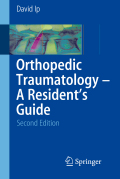
There has been very rapid development in computing in recent years and this is now a general trend in the field of orthopedics. Orthopedic trauma is no exception, as there is much enthusiasm surrounding the use of surgical navigationin musculoskeletal trauma. In light of these developments, the successful first edition of this book has been revised and updated. A lot of new informationhas been added to the original chapter on CAOS (computer-aided orthopedic surgery). Also, as the WHO has published new guidelines on osteoporosis management, together with the many conceptual changes in this area, adding a chapter onosteoporosis is both timely and appropriate. A chapter on hip fracture rehabilitation has also become necessary, not only because it echoes the teachings of the chapter on osteoporosis, but also because of the projected exponential increase in the occurrence of this fracture by the year 2050. Concise and current curriculum for the management of orthopedic trauma Introduces important concepts and provides advice Excellent resource in trauma for orthopedic residents around the world INDICE: Ten Questions for Residents.- High Energy Trauma Management.- Normal and Abnormal Bone Healing.- Principles of Fracture Fixation.- Special Types of Fractures.- New Paradigm Shift in Osteoporosis Management for Orthopods.- Minimal Invasive and Computer Aided Surgery.- Common Orthopedic Emergencies.- Trauma to Upper Extremity.- Trauma to the Lower Extremity.- Fracture Pelvis and Acetabulum.- Injuries to the Axial Skeleton.- Pediatric Trauma.- ModernGeriatric Hip Fracture Rehabilitation Protocol.- Fall Prevention in the Elderly.
- ISBN: 978-3-540-75860-0
- Editorial: Springer
- Encuadernacion: Rústica
- Páginas: 640
- Fecha Publicación: 01/02/2008
- Nº Volúmenes: 1
- Idioma: Inglés
